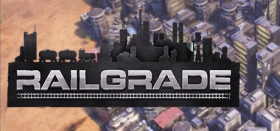
RAILGRADE Review
It’s no secret that I have an affinity for transport management games, having cut my teeth playing titles like A-Train and Transport Tycoon. However, those titles demand a decent time investment to really sit down and play properly, so it’s nice to have something lighter to hit the logistical puzzling scratch you need to itch — and RAILGRADE pulls up to the platform right on time.

Pitching itself as a train resource management game, your task is to build a network of trains to solve particular logistical problems across many different scenarios. Starting from simple things like delivering products from A to B, you find yourself tasked to build up the industries in these areas in order to maximise your efficiency and ultimately complete your tasks quicker, in turn requiring more throughput on your train network, repeat ad-infinitum.
You’re introduced to different mechanics throughout the sizable campaign at a rate that never feels overwhelming. It’s this delicate balance of progression which keeps RAILGRADE from ever feeling like it’s becoming cognitively too much. As you make your way through the early stages of the game, you find yourself wanting to learn “what’s next” in terms of new building features just as much as wanting to solve whatever puzzle it throws at you. For me, the shame is that the game’s primary score system is time-based — a rating is given to you based on how quickly you complete any given scenario. I would have liked to see it be based on slightly more complex factors like the lowest number of trains or deliveries needed or least money spent, for example, to allow more logistical solutions to the puzzles to be deliberated over, rather than just all-out speed.

Graphically, the game’s presentation is a sight to behold, donning an almost model railway-like appearance due to the top-down nature of the gameplay. You can tie your camera to one of your trains and take a virtual ride along, with a very subtle depth of field effect further lending itself to that model-like feeling where everything seems to be in miniature. The worlds are detailed well, and the ever-growing city becomes a visualisation of the tasks you’re completing as it grows and thrives under the receipt of the goods you’re sending its way.
Track placement is pretty solid, though there can be times when you need to go piece-by-piece to ensure the track goes where you want it. Sometimes, the auto-track builder, trying its best, though it may, doesn’t always quite understand what it is you’re trying to achieve. You very quickly pick up the nuances of when you’ll need to go manual with track placement, so this initial hurdle very quickly falls away.

I was taken in by the game’s soundtrack, sometimes enjoying it a bit too much that I tuned out of the puzzle I was trying to solve at the time. I’m a sucker for some synthwave, and this has it in droves, which is a perfect fit for the game’s minimally cyberpunk futuristic aesthetic.
Overall, RAILGRADE is one of those games that manages to look simple enough from the outside, yet when you start digging down into some of the later game mechanics that you have to manage, your railroads show the complexity of the beast within. Some gamers may find the tasks become a little repetitive towards the late game, but diehard logistics fans will be well served by what’s on offer. It’s a great stepping stone if you think you’d like to get into games like Factorio or Satisfactory but worry their complexities might be a bit too much for you to start with.
RAILGRADE (Reviewed on Windows)
This game is great, with minimal or no negatives.
An addictive railway management puzzler that will scratch the itch for the logical thinking part of your brain and is very enjoyable whilst doing so. Though, for some, it may become repetitive.







COMMENTS